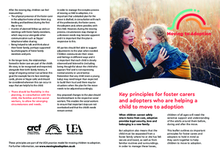Displaying 14421 - 14430 of 14562
Theoretically-informed focused commentary on the literature in this paper considers the position of children and young people as embedded within socio-ecological systems. The specific focus is on the educational disadvantage of children and young people susceptible to involvement from child protection and welfare services in the Republic of Ireland.
This dashboard from Girls Not Brides provides data on child marriage around the globe, including child marriage prevalence, country and regional data, legal age of marriage per country, and more.
Relational permanence – a form of social support characterized by the presence of an ongoing caring and supportive person in the context of the foster care system – is the primary type of social relationship that is explored in this article. Regression analyses were conducted examining whether relational permanence predicted later delinquency.
This webpage from the Children's Trust Fund Alliance features research and theory of change, training, and resources on prevention child neglect.
This resource from Save the Children answers the questions: (1) Why should we consider integrating Cash and Voucher Assistance (CVA) and Child Protection (CP) during COVID-19?; (2) What type of CVA & CP programming can be done during COVID-19?; and (3) How can we integrate CVA & CP?
In this first episode of a new special series on child development and COVID-19, Center Director Dr. Jack Shonkoff and host Sally Pfitzer discuss how to support healthy child development during a pandemic, including the importance of caring for caregivers.
"UN human rights experts have appealed to States to boost child protection measures to help safeguard the welfare of millions of children worldwide who may be more exposed to violence, sale, trafficking, sexual abuse and exploitation during the COVID-19 pandemic," says this press release from the United Nations Office of the High Commissioner on Human Rights.
This leaflet outlines six important principles for foster carers and adopters to hold in mind as they work together to help children to move to adoption.
This brief report describes social media-based advertising strategies employed to recruit an anonymous sample of young adults who had recently aged out of foster care to participate in an online survey.


